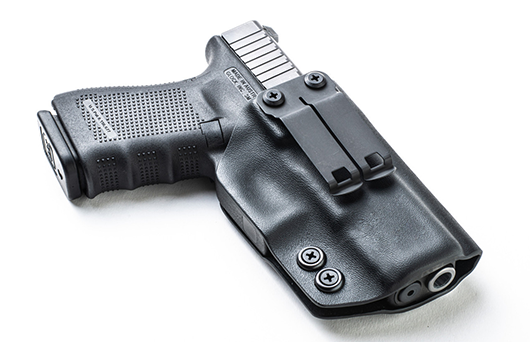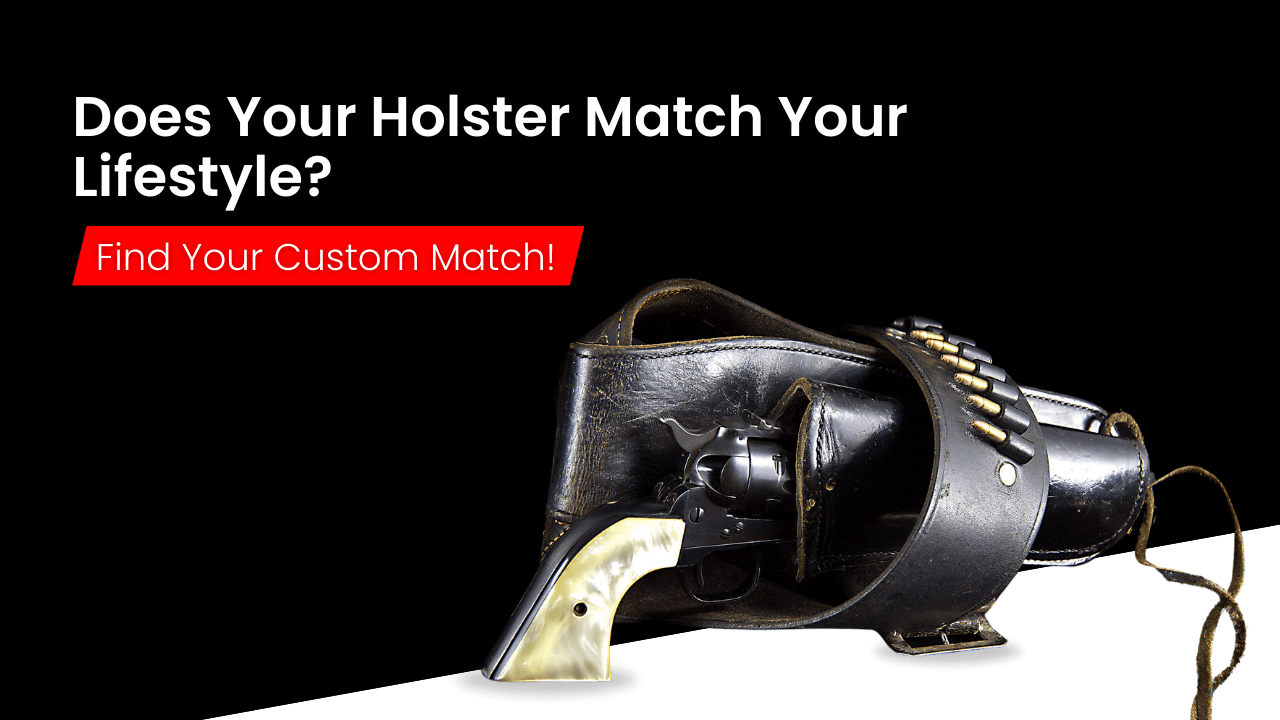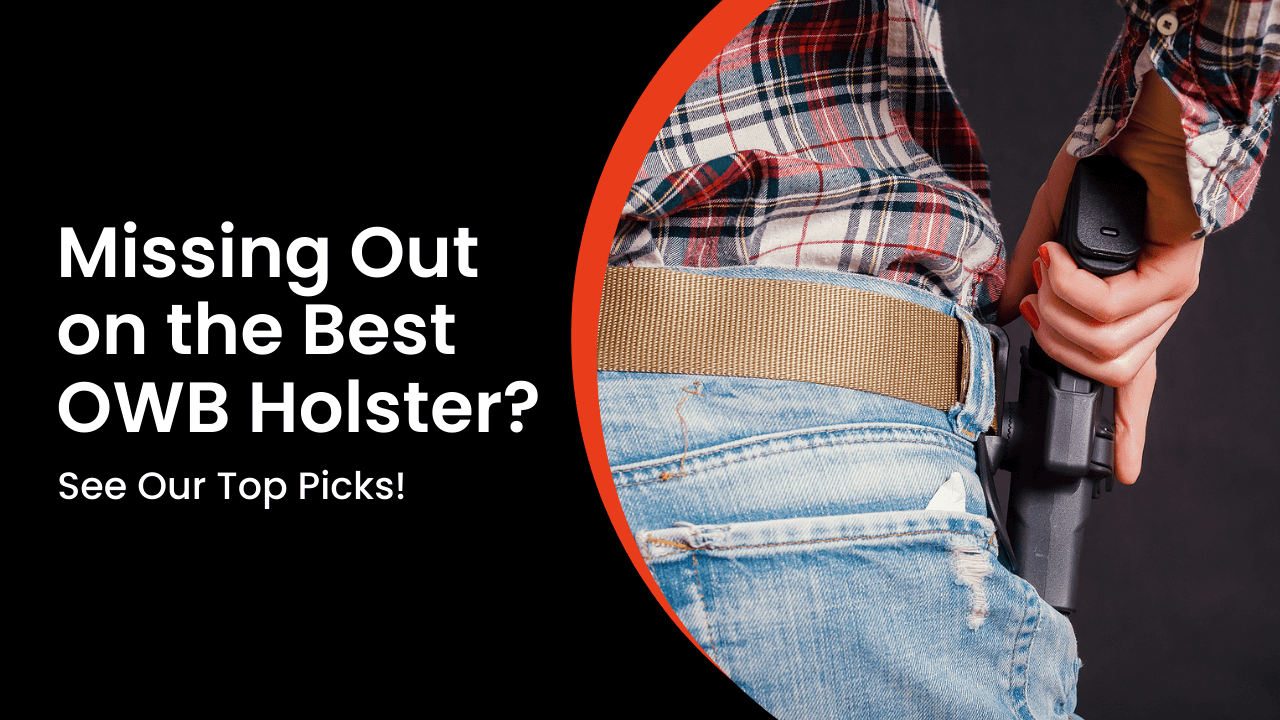A Brief Guide to Holster Cant
May 26th 2023
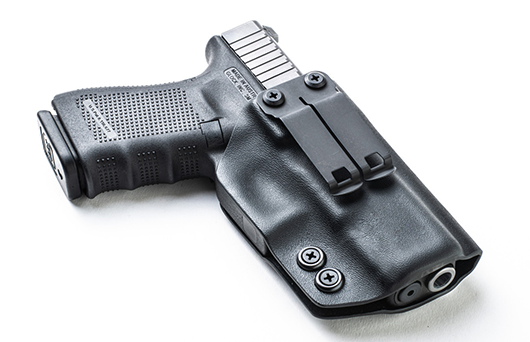
Modern gun holsters feature a wide range of options and features to improve the comfort and convenience of today’s gun owners and concealed carriers. However, a lesser-known aspect of efficient concealed carry is holster cant.
Learn what a holster cant is, why it matters, and how your cant angle can help you carry your handgun more comfortably and efficiently.
Holster Cant Defined
The holster cant, also sometimes called holster cant angle, is a term that refers to the holster’s angle relative to the waistband. Different cant angles result in varying handgun orientations on the body, providing gun owners with multiple options to adjust their gun’s position and improve their draw strokes, comfort, or concealment.
The Importance of Holster Cant
If you are familiar with concealed carry, you may already know the importance of using good holster materials, selecting the right carry position or modifying your holster with accessories like wedges and mod wings to facilitate drawing and concealment.
Your holster cant is another essential factor that, if properly adjusted and adapted to your carry style and habits, can enhance comfort and concealment. The right cant angle can also help you draw your handgun more quickly and comfortably, which can benefit you significantly in an emergency, such as when you need to draw in self-defense.
However, choosing the wrong cant angle for your carry habits and preferences can have the inverse effect, such as uncomfortable angles, reducing concealability, or making it more challenging to reach and draw your handgun’s grip.
Types of Holster Cant Angles
Holster cant angles are categorized into vertical, positive, and negative. Most adjustable holsters provide shooters with a 60-degree range of cant adjustment, from negative 30 (-30°) to positive 30 (+30°).
Vertical Cant
A vertical cant angle, also known as the zero cant or neutral cant, is what you obtain when the holster is adjusted at a 0° angle, meaning your handgun’s barrel is perpendicular to your waistline. With a vertical cant, your holster presents your handgun in a straight line, parallel with your arms at rest.
The vertical cant is most commonly associated with holsters carried in the strong-side position, mainly traditional outside the waistband (OWB) holsters in the 3 o’clock position for right-handed shooters and 9 o’clock for left-handed shooters.
The vertical cant is strongly associated with traditional handgun carry methods, such as open carry. While it is possible to use a vertical cant in concealed carry, it isn’t necessarily the best option because this angle can impede concealability and introduce printing when carrying inside the waistband (IWB).
Positive Cant
A positive cant angle, also called forward cant, is a holster oriented in a positive angle, causing the handgun to be rotated slightly forwards, with the barrel pointed ahead of the shooter instead of being perpendicular to the ground. Positive cant rotates the grip so the backstrap is angled slightly behind the shooter instead of straight up.
The primary purpose of positive cant angles is to present more of the handgun’s grip toward the shooter than a vertical cant. When adjusted to the shooter’s preferences and carry position, a positive cant increases concealment due to the handgun’s barrel resting at a diagonal angle. Holsters adjusted with positive cants are typically concealment holsters, such as IWB holsters for smaller handguns.
Positive cant holsters also improve draw speed because the holster presents the grip and backstrap at a more comfortable angle for the shooter’s wrist. However, a positive cant can be uncomfortable, especially when sitting down, as the handgun’s grip may dig into the shooter’s body.
Negative Cant
A holster with a negative cant angle, also called reverse cant, orients your handgun at a negative angle, with the barrel pointed slightly behind the shooter. It rotates the grip slightly forward of the shooter. When done to a holster for a semi-automatic pistol, the shooter will see more of the magazine’s base plate presenting up.
Although negative cant angles may seem counterintuitive at first glance, as they can make it harder to reach and grip the handgun, this holster orientation offers several benefits when paired with specific carry positions.
Carry positions such as small-of-the-back carry (approx. 6 o’clock) and cross-draw can present the handgun’s grip at a comfortable angle, making it easier and faster to draw for these positions.
With the correct holster materials and configuration, negative cant holsters can also improve concealment because they orient the handgun at angles that are less likely to cause printing. However, the grip angle may only be comfortable for some shooters, and the wrong holster position for this cant angle can harm draw times and make it harder to reach your handgun.
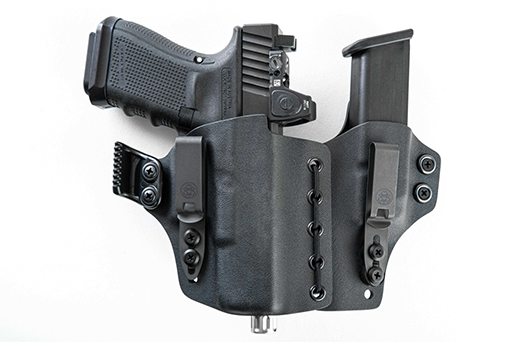
Factors Influencing Holster Cant Angle Selection
To choose a suitable cant angle for your carry holster, you must first understand how your carry habits influence your choice. Your holster type and carry position, body type, draw stroke, ride height, and concealment needs all affect cant angle selection.
Holster Type
One of the most critical factors influencing your cant angle choice is the type of gun holster you wear. You can only adjust your holster’s cant if you wear a belt-mounted holster, such as an IWB, OWB, paddle, or appendix carry (AIWB) holster. While some types of shoulder holsters allow you to adjust the cant angle, this holster type has different safety and concealment considerations, requiring you to follow shoulder holster-specific advice.
Carry Position
Your holster’s position on your gun belt influences cant angle choices. Depending on how you carry your holster, a given cant angle may be beneficial in specific carry positions but uncomfortable in others.
- Strong-side hip carry: If you primarily use holsters in the strong-side position, such as 3 o’clock for right-handed shooters and 9 o’clock for left-handed shooters, the most comfortable cant angles tend to range between a zero cant (0°) and a slight positive cant (+15°).
- Appendix carry: Appendix carry positions, which place the holster closer to the 12 o’clock position, benefit the most from a slightly negative cant, typically between -7.5° and -15°. Because the handgun is located directly in front of the shooter’s body, a slight negative angle can help present the handgun at a more comfortable angle, making it easier to draw.
- Behind-the-hip carry: Behind-the-hip carry positions, typically ranging between 4 and 5 o’clock for right-handed shooters and 7 to 8 o’clock for left-handed shooters, can benefit from a more aggressive holster cant. Due to the holster’s position behind the hip, the shooter must reach behind themselves and orient their wrist at different angles than they would use with a holster riding on the strong side. For this reason, recommended cant angles are positive and range from a medium +15° to a more pronounced +22.5°.
- Small-of-the-back carry: If your handgun rides between the 5 and 6 o’clock position on your gun belt as a right-handed shooter or between 6 and 7 o’clock as a left-handed shooter, aggressive cant angles may be the most beneficial, as they present the grip in a more natural position to a shooter reaching behind their body to draw. Choose a positive cant angle if you carry palm-in and a negative angle if you carry palm-out.
- Cross-draw carry: Carrying cross-draw means carrying a holster on the side opposite of your dominant hand. For example, a typical cross-draw carry position for a right-handed shooter is 11 o’clock. Pairing this carry position with a medium to aggressive negative cant angle (-15° to -22.5°) typically improves comfort and ease of access, especially when seated.
Body Type
If you’ve been carrying concealed guns for a while, you may already know that your body type influences the carry positions that might work best for you. The same is true of cant angles. Below is a breakdown of recommended carry positions and cant angles for multiple body types to achieve the best comfort.
- Thinner and skinny builds: Gun owners and shooters who lean on the skinny side may already know that some traditional concealed carry positions, such as strong-side or behind-the-hip carry, are more challenging to use. If you have a thinner build, consider using appendix carry with a more pronounced negative cant, such as -15°, to reduce printing as much as possible.
- Average builds: Traditional carry positions were designed with shooters of relatively average build in mind. If you have an average build, you should be able to conceal a handgun effectively in nearly any position. Start from a slight forward cant angle (+7.5° to +15°) if you carry strong-side and a slightly more pronounced forward cant (+15° to +22.5°) if you carry behind-the-hip, then adjust from there to your preferences.
- Large and portly builds: Bigger shooters may generally find concealed carrying more challenging, regardless of the position. However, carry positions such as appendix carry and cross-draw with a pronounced negative cant are a good starting point to improve comfort, especially when seated. Start from -15° and adjust from there. You may also want to consider carrying in the 2-3 o’clock position (or 9-10 o’clock for left-handed shooters) to improve comfort and concealment further.
Draw Stroke
The draw stroke is the particular set of motions performed to pull a handgun out of a holster and present it at a target. While your draw stroke is influenced by your training, holster type, and carry position, one of the most overlooked factors is the circumstances surrounding the need to draw and shoot.
For instance, drawing and shooting at a range or while participating in a competitive shooting event, such as IDPA, will put you in different postures and body positions than shooting for self-defense or combat applications.
When drawing a handgun in a defensive scenario, you are highly unlikely to remain in a straight posture, such as standing up and drawing from a vertical stance. Most shooters reacting to defensive scenarios will instinctively lower their center of gravity when responding to a threat, bending down and forward.
If you carry a handgun for self-defense, accounting for your body’s natural and intuitive reactions is critical when choosing the right cant angle. Take note of the natural angles of your body, arms, and wrists when drawing a handgun; if you notice you have to contort your arms or bend in uncomfortable ways to draw your handgun, you may need to adjust your cant angle until your draw stroke feels more natural.
Concealment Considerations
If you primarily carry your handgun concealed, you know that the right choice of handgun, holster materials, carry position, and even ride height can affect how concealable your holster is and how likely it is to print.
Consider pairing your preferred carry position with the best holster cant angle to maximize concealment. Although maximizing concealment may not always improve comfort or come at a slight cost in draw speed and ease of access, prioritizing concealment can help you avoid printing in most circumstances.
- Strong-side hip carry: The theoretical best cant angle to maximize concealment when carrying strong-side is a slight forward cant (+7.5°). Although each shooter is different, most strong-side hip carry shooters have obtained the best results for concealment by choosing this cant angle.
- Appendix carry: In this carry position, the best cant angle to maximize concealment is a vertical cant (0°). While it may come at the cost of comfort, particularly when seated, a vertical cant in the appendix position is the best solution to conceal even the largest handguns, such as full-size pistols.
- Behind-the-hip carry: The most popular cant angle for this carry position is a forward cant of 15° due to its association with the FBI cant or FBI carry position. It offers an excellent balance of comfort, ease of access, and concealment.
- Small-of-the-back carry: The ideal cant angle for this carry position depends on whether you prefer to carry palm-in or palm-out. Palm-in means your palm faces towards your body when you grip your gun, whereas palm-out means your palm faces behind you. When drawing palm-in, the best cant angle for concealment is a medium positive cant (+15°). If you draw palm-out, use a similar angle with a negative cant (-15°).
- Cross-draw carry: Shooters who opt for the cross-draw carry position when concealed-carrying may obtain the best results for concealment by using a slight negative cant (-7.5°).
Popular Holster Cant Angles
Below are popular cant angles used by civilian shooters and law enforcement agencies.
FBI Cant
The most well-known cant angle is the FBI cant or FBI carry, as popularized by Federal Bureau of Investigation field agents. The FBI cant is a mild positive cant of +10° to +15°, typically paired with a carry position ranging from strong-side hip carry to behind-the-hip carry.
FBI agents adopted this carry method in the 1980s, shortly after the agency began switching from revolvers to semi-automatic pistols, such as the Smith & Wesson 459, the SIG P226, and SIG P228. Combining a behind-the-hip carry position with a mild positive cant angle allowed FBI agents to conceal their sidearms more efficiently while improving their draw stroke.
Appendix Cant
Although not unique to this carry position, the appendix cant refers to what many shooters consider the ideal cant angle for a specific combination of holster type, carry position, and gun type.
When carrying a full-size handgun or large revolver in an AIWB holster at the 12 o’clock position, the most popular cant angle for this configuration is a negative -7.5° cant.
This angle allows the barrel of your handgun to align naturally with your groin’s angles and limits or eliminates discomfort typically associated with AIWB carry, such as your gun’s barrel poking into the thigh.
Western-style Cant
Historically related to the Old West, classic leather holsters and single action revolvers of old, the Western-style cant refers to both a specific cant angle and a particular style of gun holster.
Holsters with a Western-style cant are designed for OWB cross-draw carry, feature shells intended for revolvers, and have an aggressive negative cant angle, typically -30°. Their original purpose is to allow a shooter to carry and draw a sidearm from horseback as safely as possible.
Some modern-manufacture holsters still feature the distinctive Western-style cant and are well-suited for shooters who need a comfortable holster for carrying in a seated position.
Although not generally intended for concealed carry, savvy shooters can use a Western-style cant angle to their advantage by wearing a jacket over the belt and holster. The aggressive cant reduces the risk of printing or seeing the holster’s tip poke out from under the jacket, making it easier to conceal.
Tips for Choosing the Right Holster Cant
Although some holster cant angles are better suited for specific holster types and carry positions than others, the best way to find the best holster cant for your needs is to experiment with your existing concealed carry setup.
Every shooter has a different body shape, height, build, and personal preferences, meaning that even an ideal cant angle for your preferred ride height and carry position may not be suitable for you. You must also ensure that your cant angle lets you carry comfortably and without printing while wearing your preferred clothes and cover garments.
Experiment with your concealed carry holster until you find a combination of position, ride height, and cant angle that provides the best comfort, concealment, and draw speed.
If you need further assistance finding the right holster cant or configuring your holster for your needs, ask a holster professional at Incognito Concealment. Our staff has the expertise and knowledge to help you adjust your concealed carry setup to your needs.
How to Adjust My Holster Cant
Adjusting your concealment holster’s cant is a relatively simple task. You only need the right tool to loosen your holster’s belt clips to adjust your holster’s cant angle. For additional safety, perform all the steps below with a fully unloaded handgun.
- Remove your handgun from the holster, then place the holster on a flat surface.
- Locate your holster’s belt clips and check which hardware is used to fasten it to your holster shell, such as screws or hex nuts.
- Loosen your belt clip’s hardware with an appropriate tool, such as a screwdriver, a wrench, or an Allen key. You do not need to remove the hardware; simply loosen it as much as necessary to rotate the clip around.
- Once loosened, rotate the belt clip to the desired angle.
- Fasten your belt clip’s hardware again.
- Insert your handgun into the holster, and align your holster so the belt clip is perpendicular to a straight, horizontal line. You can observe your cant angle by comparing the orientation of your barrel with that of your belt clip.
- Test your cant angle by wearing the holster on your gun belt and check whether it fits your concealed carry setup by checking the carry position, ride height, and preferred clothing.
Find the Ideal Adjustable Holster at Incognito Concealment
Whether you prefer traditional IWB holsters, appendix carry holsters, classic OWB holsters, or convenient paddle holsters, Incognito Concealment carries an extensive selection of models compatible with hundreds of handgun makes and models.
Our concealment holsters feature adjustable belt clips letting you precisely configure your favorite holster cant angle. Contact us to learn more about our products or for more tips on improving your concealed-carrying experience.

